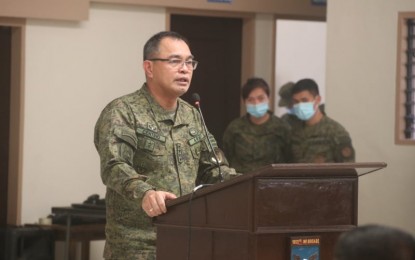
(PNA file photo)
MANILA – The hardship being experienced by members of the New People's Army (NPA) inside the organization is one of the reasons why more are surrendering to the Armed Forces of the Philippines (AFP).
"The hardships inside the NPA organization are now taking their toll on its members, leading them to return to the folds of the law. The AFP welcomes them and is willing to offer them assistance in line with our government local integration programs,” AFP chief Gen. Andres Centino said in a statement Monday night.
He made this comment after meeting his long-time enemy, Maximo Catarata alias Datu Makatindog, the former highest-ranking leader of the weakened Guerrilla Front 3 of the NPA during his visit to the 10th Infantry Division headquarters in Camp General Manuel T. Yan Sr. Tuboran, Mawab, Davao de Oro last April 23.
Catarata surrendered along with his M16 rifle to government forces at the 60th Infantry Battalion headquarters in Asuncion, Davao del Norte on March 31.
The former NPA leader decided to return to the folds of the government due to the hardship he experienced inside the armed group and recent serious debacles that resulted in the mass surrender of most of his subordinates.
He was previously hunted for multiple cases of attempted murder, child labor and rebellion.
Prior to his surrender, three other members of the NPA’s Guerrilla Front 3 surrendered to the 60th Infantry Battalion on March 29.
They were Emy Ansag Camilo, logistics officer; and GF3 elements Nilo Oyda Moluhinday and Reyan Bagubay Moluhinday. His voluntary surrender was made possible through the relentless intelligence efforts of the 10th Infantry Division and 60th Infantry Battalion.
“Catarata is a living proof of the government’s sincerity in giving former rebels a chance to live a normal and peaceful life not only by ensuring the safety of their families but also by empowering them to become productive citizens of our country,” Centino said.
Before being appointed AFP chief, Centino commanded the Army’s 26th Infantry Battalion in 2008. The unit operated in the southern part of Agusan del Sur where Catarata’s group was once very active.
Centino continued to hunt down the elusive NPA leader when he commanded the 401st Brigade in Agusan del Sur Province and Southern Agusan del Sur in 2017.
On February 26, Catarata’s son, Renard Galos Catarata, who is also the commanding officer of GF3, together with 12 others surrendered to the 60th Infantry Battalion bringing along with them high-powered firearms.
The surrenders consequently lead to the dismantling of GF3 and two other NPA units operating in the tri-boundaries of Agusan Sur, Davao De Oro and Davao Del Norte.
The AFP earlier said that around 266 NPA rebels, majority from its units in Eastern Mindanao, have returned to the fold of the law for the first three months this year.
These can be broken down into 114 from Eastern Mindanao, 58 from Western Mindanao, 37 from Southern Luzon, 36 in the Visayas, 20 in Northern Luzon, and one from Palawan.
Authorities also recorded 37 NPA members killed and 29 apprehended in operations nationwide for the same period. Among the most wanted rebels who died in a firefight was Menardo Villanueva in Barangay Libudon, Mabini, Davao de Oro on January 12.
Villanueva is the commander of the NPA's national operations command and a long-time secretary of the National Democratic Front (NDF) Southern Mindanao Regional Committee.
He also served as head of the Communist Party of the Philippines (CPP) Mindanao Commission and as Political Bureau Chief of the CPP's central committee.
Government troops also reduced the NPA's firepower with the seizure and surrender of 492 high-powered and low-powered firearms and 148 anti-personnel mines that the International Humanitarian Law strictly prohibits.
The military's operations, getting information from concerned citizens and former NPA rebels, resulted in the discovery of 66 communist terrorist encampments, mostly in Eastern Mindanao and the Visayas.
The military has attributed the gains against the communist terrorists to the support of communities and local government units through the National Task Force on Ending Local Communist Armed Conflict (NTF-ELCAC).
The CPP-NPA is listed as a terrorist organization by the United States, the European Union, the United Kingdom, Australia, Canada, New Zealand, and the Philippines.
The NDF has been formally designated as a terrorist organization by the Anti-Terrorism Council on June 23, 2021, citing it as “an integral and inseparable part” of the CPP-NPA created in April 1973. (PNA)
